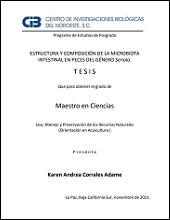Mostrar el registro sencillo del ítem
ESTRUCTURA Y COMPOSICIÓN DE LA MICROBIOTA INTESTINAL EN PECES DEL GÉNERO Seriola
| dc.contributor.advisor | Tovar Ramírez, Dariel | |
| dc.contributor.advisor | Quiroz Guzmán, Eduardo | |
| dc.contributor.author | Corrales Adame, Karen Andrea | |
| dc.date.issued | 2021 | |
| dc.identifier | https://cibnor.repositorioinstitucional.mx/jspui/handle/1001/2494 | |
| dc.identifier.uri | http://dspace.cibnor.mx:8080/handle/123456789/3099 | |
| dc.description.abstract | "La acuicultura es un sector que ha crecido considerablemente en las últimas décadas y las especies del género Seriola se han hecho cada vez más presentes en el mercado gracias a su fácil adaptación y calidad en la carne. Por otro lado, se ha demostrado que la microbiota intestinal tiene un papel esencial en el crecimiento, desarrollo y salud de los peces, ya que desempeña diversas funciones en la absorción de nutrientes e inmunidad frente a patógenos. El presente trabajo tuvo como objetivo estudiar la composición de la microbiota intestinal en peces del género Seriola, así como, caracterizar las diferencias y similitudes que existen entre estos. Para ello, se seleccionaron tres trabajos realizados en peces del género Seriola, donde la plataforma de secuenciación Ilumina fuera utilizada y se haya amplificado la región hipervariable V3 del gen 16S ARN ribosomal. Se analizaron las secuencias de dos estudios realizados en Seriola lalandi (México y Australia), y uno en Seriola rivoliana (México). Cada estudio formó un grupo diferente y se les identificó como M1, A1 y M2, respectivamente. Se extrajeron las secuencias originales de cada estudio para los análisis bioinformáticos y estadísticos. Se observó que existe una gran abundancia de bacterias a nivel de orden y familia en cada de uno de los estudios. El grupo de Australia (A1) presentó una abundancia relativa elevada de bacterias pertenecientes a la familia Vibrionaceae, mientras que los grupos de México (M1 y M2) mostraron una mayor abundancia relativa de otras familias como Sphingomonadaceae y Enterobacteriaceae. El índice Shannon demostró que M2 es diferente estadísticamente de A1 en cuanto a diversidad, mientras que en M1 y A1 no existe dicha diferencia. El índice Chao señaló que no hay diferencias estadísticas significativas con respecto a la riqueza de cada grupo. Por otro lado, el análisis de la diversidad beta indicó que los tres grupos son diferentes entre sí. Los análisis descriptivos no mostraron una microbiota común entre los 3 grupos a nivel de unidad taxonómica operativa (OTU) ni a nivel de familia. Sin embargo, se identificó a la familia Deviosiaceae como el core entre los grupos de México. Dichos resultados mostraron que, a pesar de que M1 y A1 son de la misma especie, existe mayor similitud en cuanto a la composición microbiana entre M1 y M2, los cuales tuvieron condiciones de cultivo similares..." | es |
| dc.format | es | |
| dc.language.iso | spa | es |
| dc.publisher | Centro de Investigaciones Biológicas del Noroeste, S.C. | es |
| dc.rights | Acceso abierto | es |
| dc.subject | Seriola, microbiota intestinal, microbiota común, México, Australia | es |
| dc.subject | Seriola, intestinal microbiota, core microbiota, Mexico, Australia | es |
| dc.subject.classification | METABOLISMO MICROBIANO | es |
| dc.title | ESTRUCTURA Y COMPOSICIÓN DE LA MICROBIOTA INTESTINAL EN PECES DEL GÉNERO Seriola | es |
| dc.type | masterThesis | es |
| dc.dirtesis.grado | Maestría en Ciencias en el Uso, Manejo y Preservación de los Recursos Naturales | es |
| dc.dirtesis.disciplina | Acuicultura | es |
| dc.dirtesis.universidad | Centro de Investigaciones Biológicas del Noroeste, S.C. | es |
| dc.dirtesis.facultad | Posgrado en Recursos Naturales | es |
| dc.description.abstracten | "Aquaculture is a sector that has grown considerably in recent decades and species of the genus Seriola have become increasingly present in the market due to their easy adaptation and good meat quality. On the other hand, it has been demonstrated that the intestinal microbiota has a fundamental role in the growth, development and health of fish, as it performs diverse functions in the absorption of nutrients and immunity against pathogens. The aim of the present work was to study the composition of the intestinal microbiota in fish belonging to the genus Seriola, as well as to characterize the differences and similarities that exist between them. For this purpose, three studies carried out exclusively in fish of the genus Seriola were selected, where the Illumina sequencing platform was used and the V3 hypervariable region of the 16S rRNA gene was amplified. The sequences of two studies carried out in Seriola lalandi (Mexico and Australia), and one in Seriola rivoliana (Mexico) were analyzed. Each study formed a different group and were identified as M1, A1 and M2, respectively. Raw sequences were extracted from each study for bioinformatics and statistical analyses. It was observed that there is a high abundance of bacteria at the order and family level in each of the studies. The Australian group (A1) had a high abundance of Vibrionaceae bacteria, while the Mexican groups (M1 and M2) had a higher presence of other families such as Sphingomonadaceae and Enterobacteriaceae. The Shannon index showed that M2 is statistically different from A1 in terms of diversity, while in M1 and A1 there is no such difference. The Chao index noted that there are no significant statistical differences regarding the richness of each group. On the other hand, the beta diversity analysis indicated that the three groups are different from each other. Descriptive analyses showed no common microbiota among the groups at the OTU and family level. However, the Deviosiaceae family was presented as the core among the Mexican groups. These results showed that, despite the fact that M1 and A1 are of the same species, there is greater similarity in terms of microbial composition between M1 and M2, which had similar culture conditions. From this work it was possible to conclude that external factors have a greater influence than the genetics of the organisms in shaping the intestinal microbiota..." | es |




